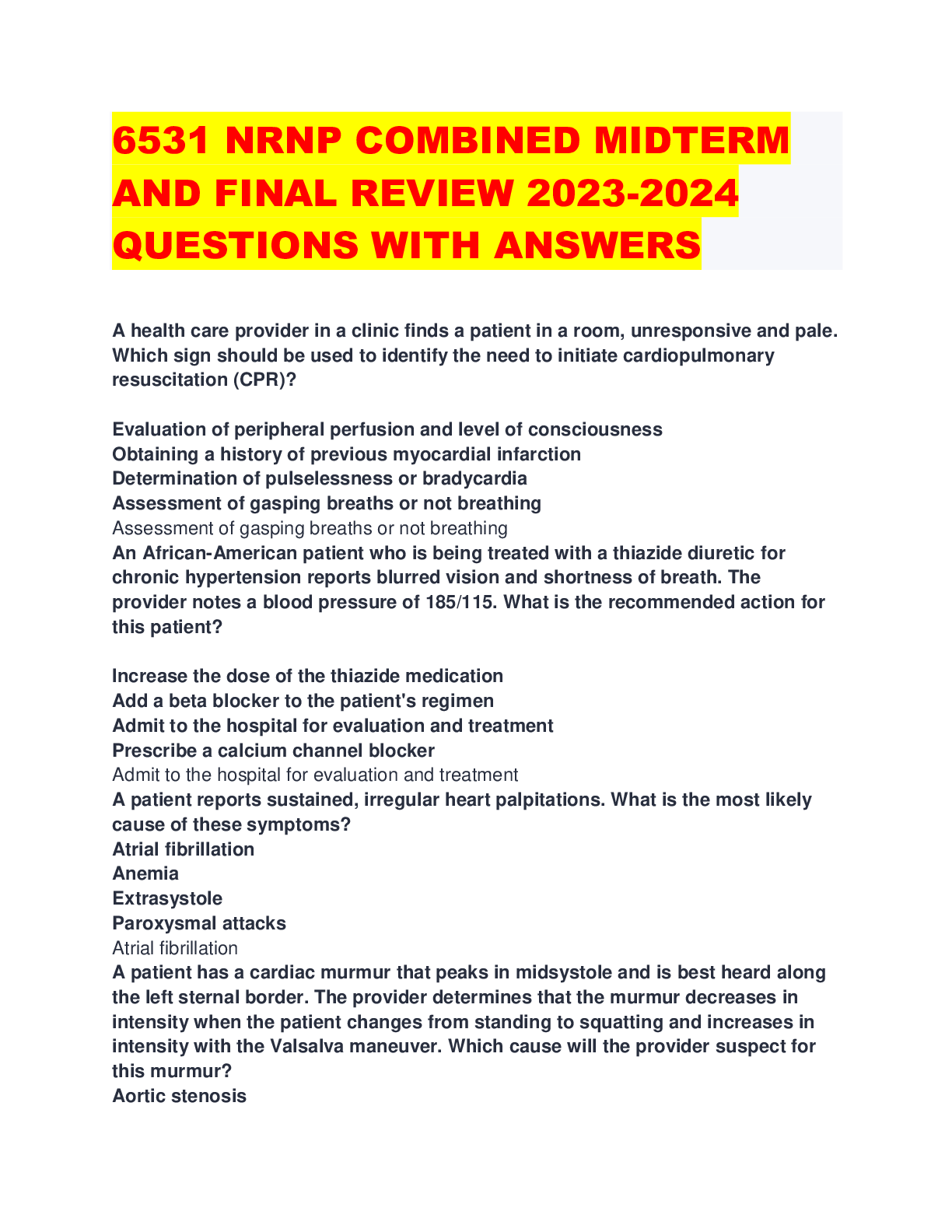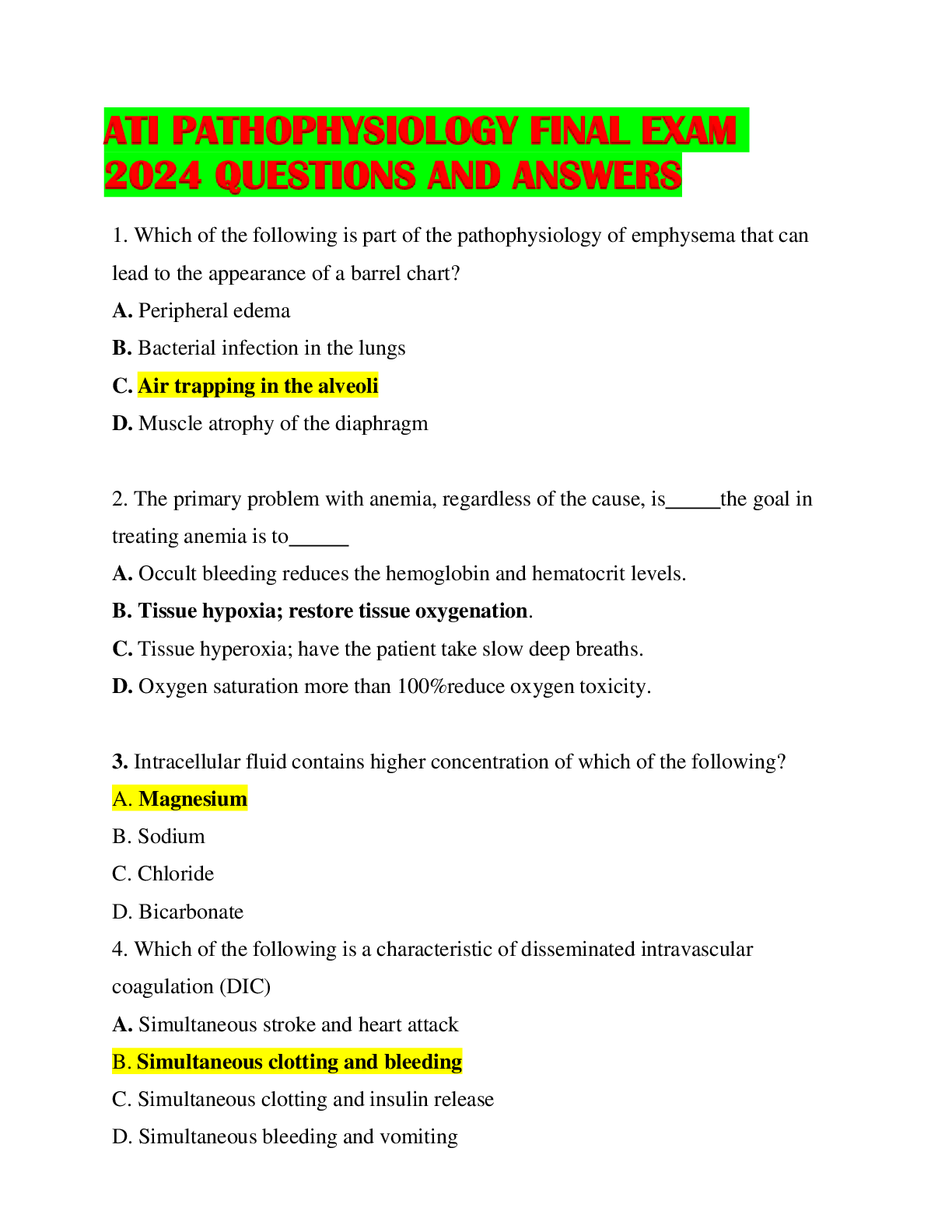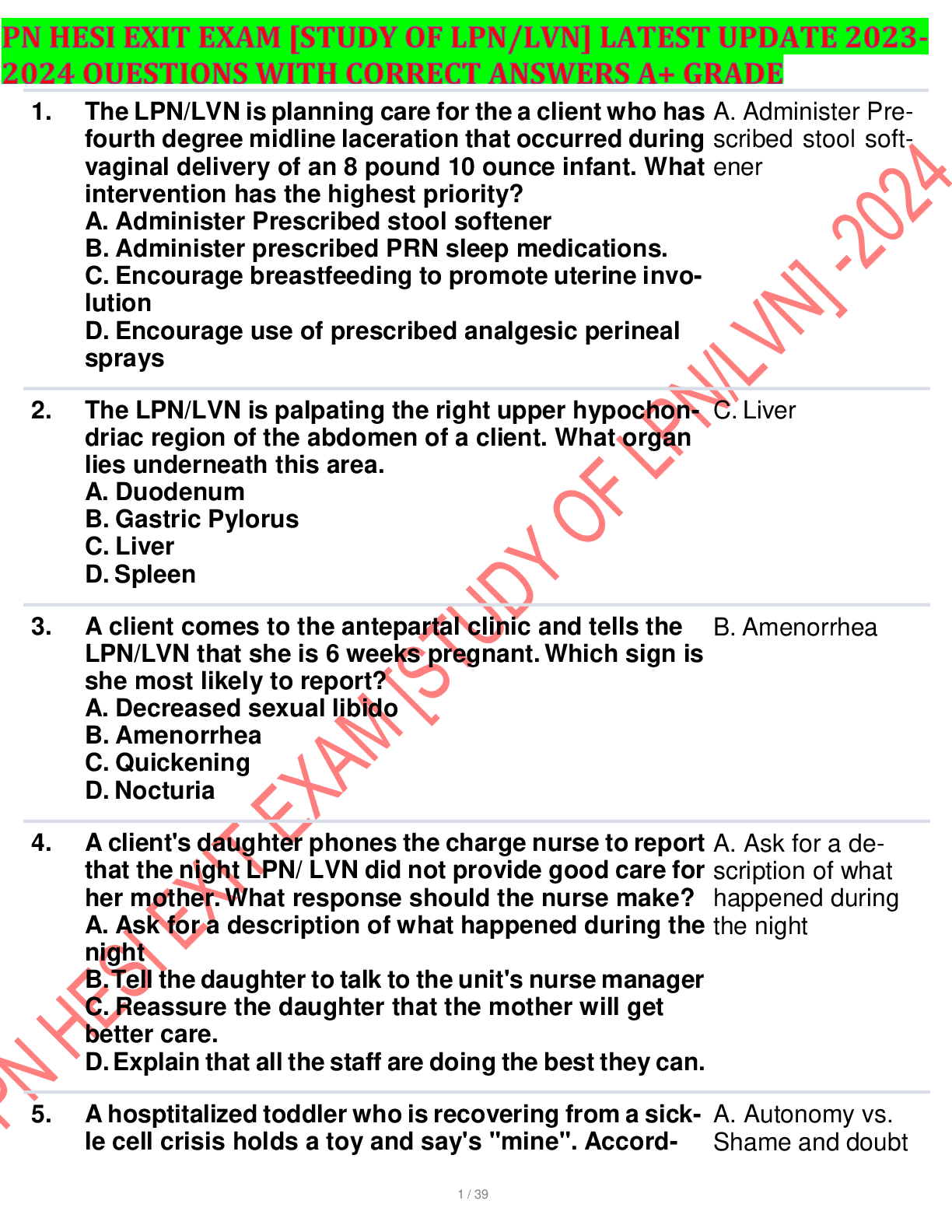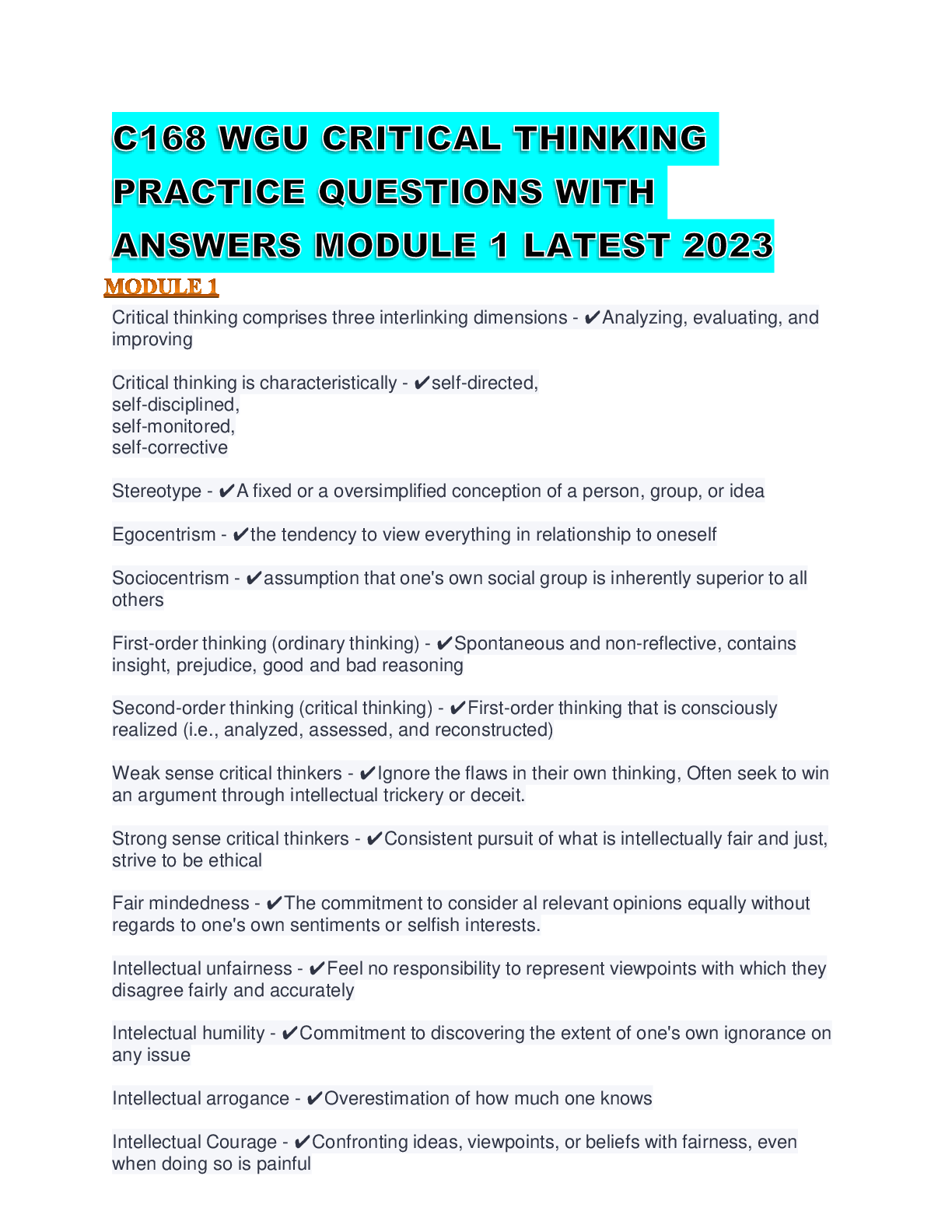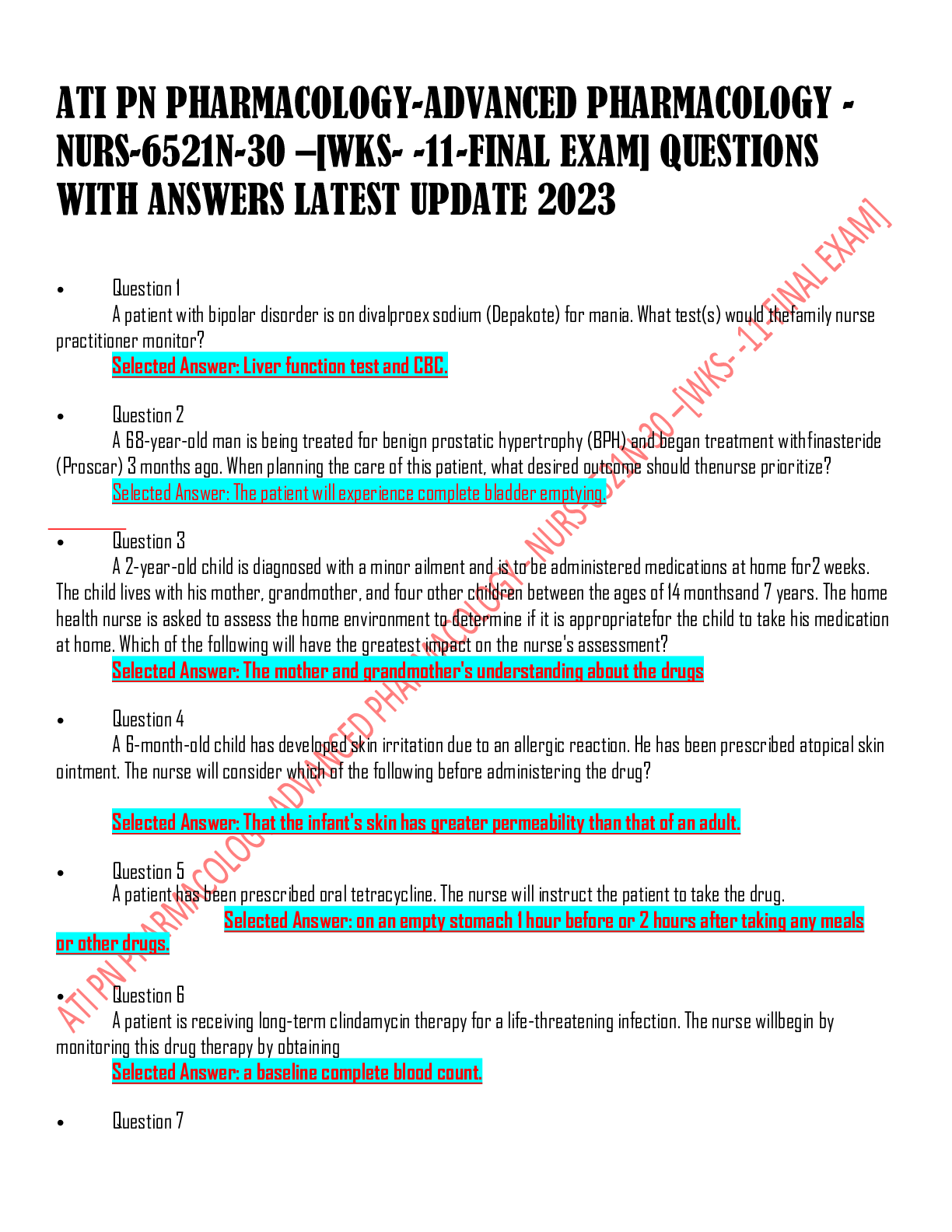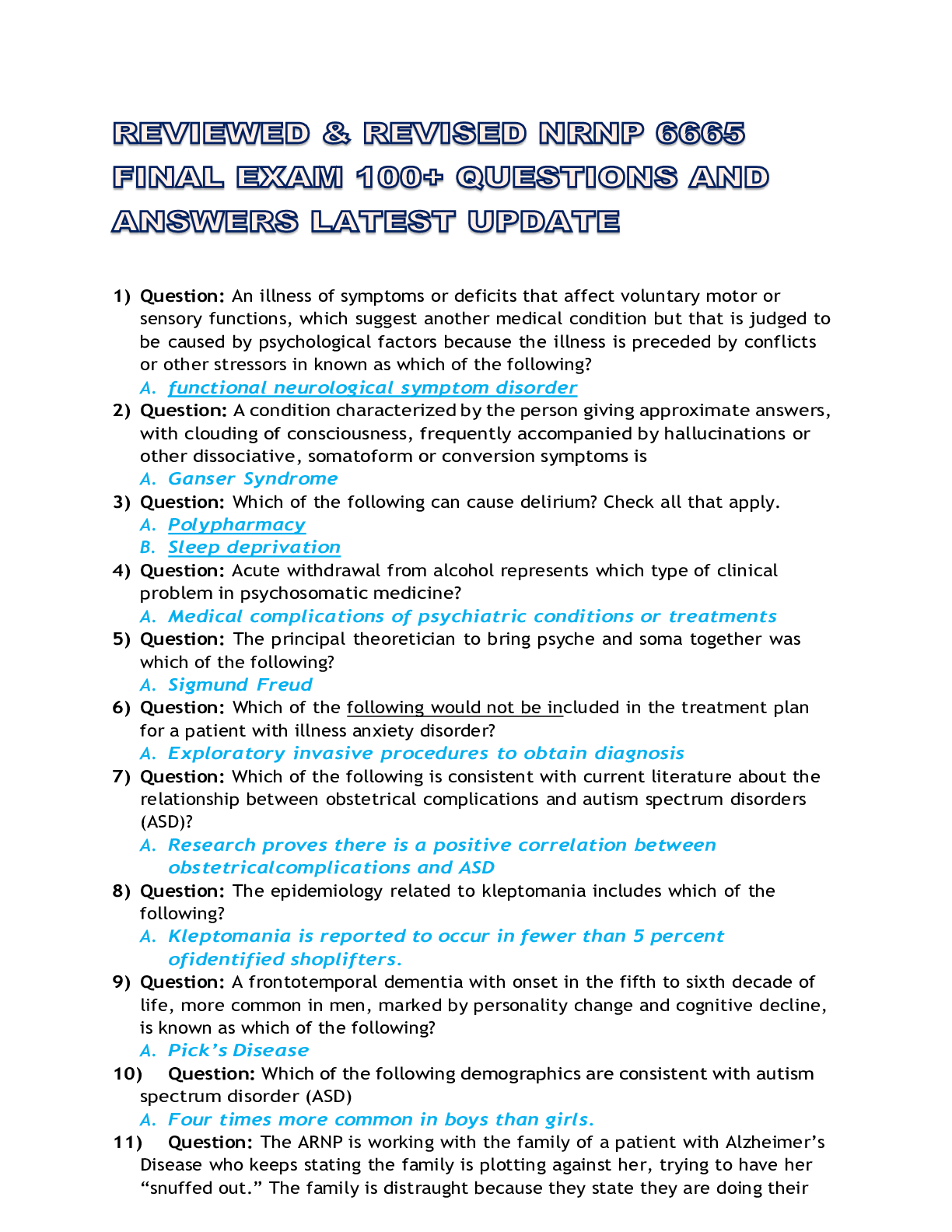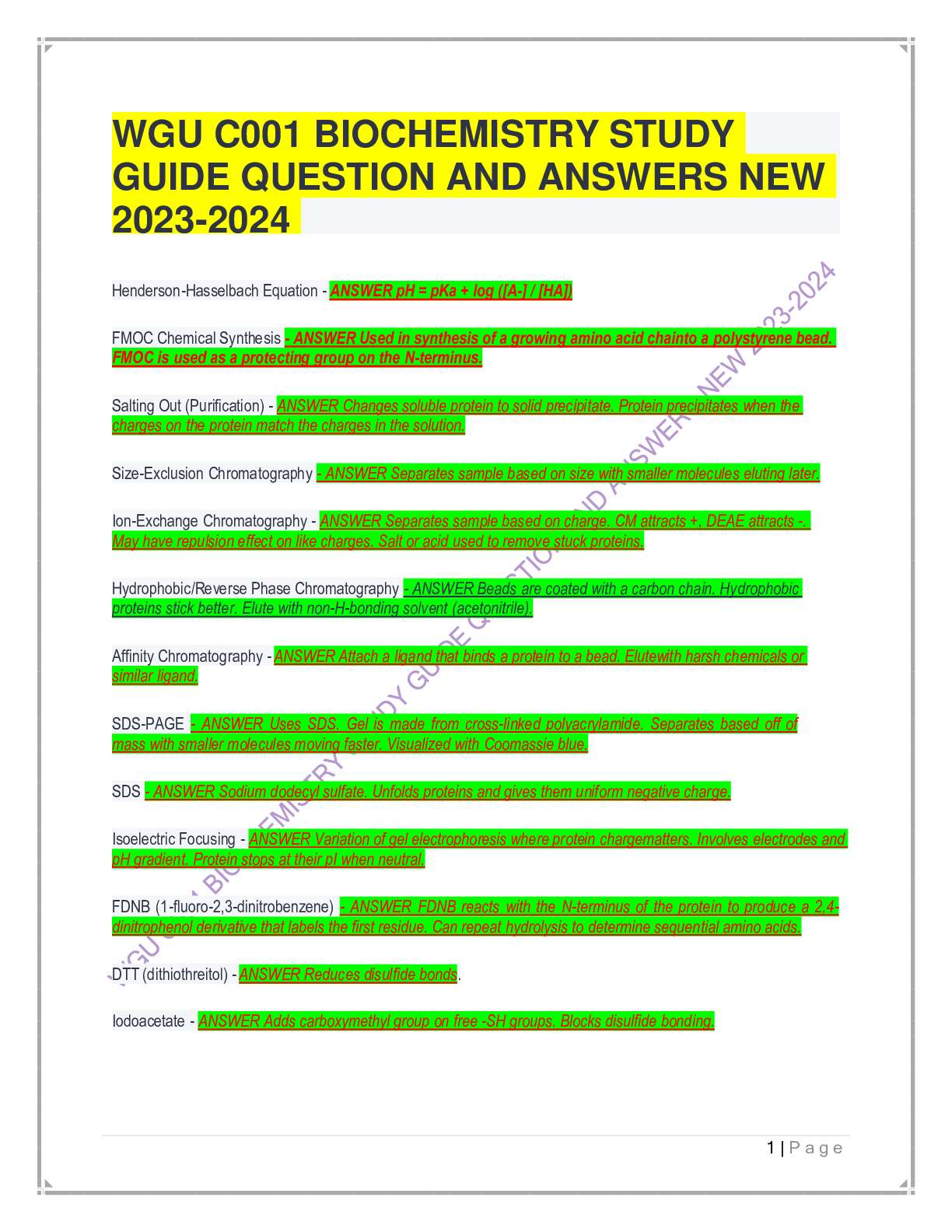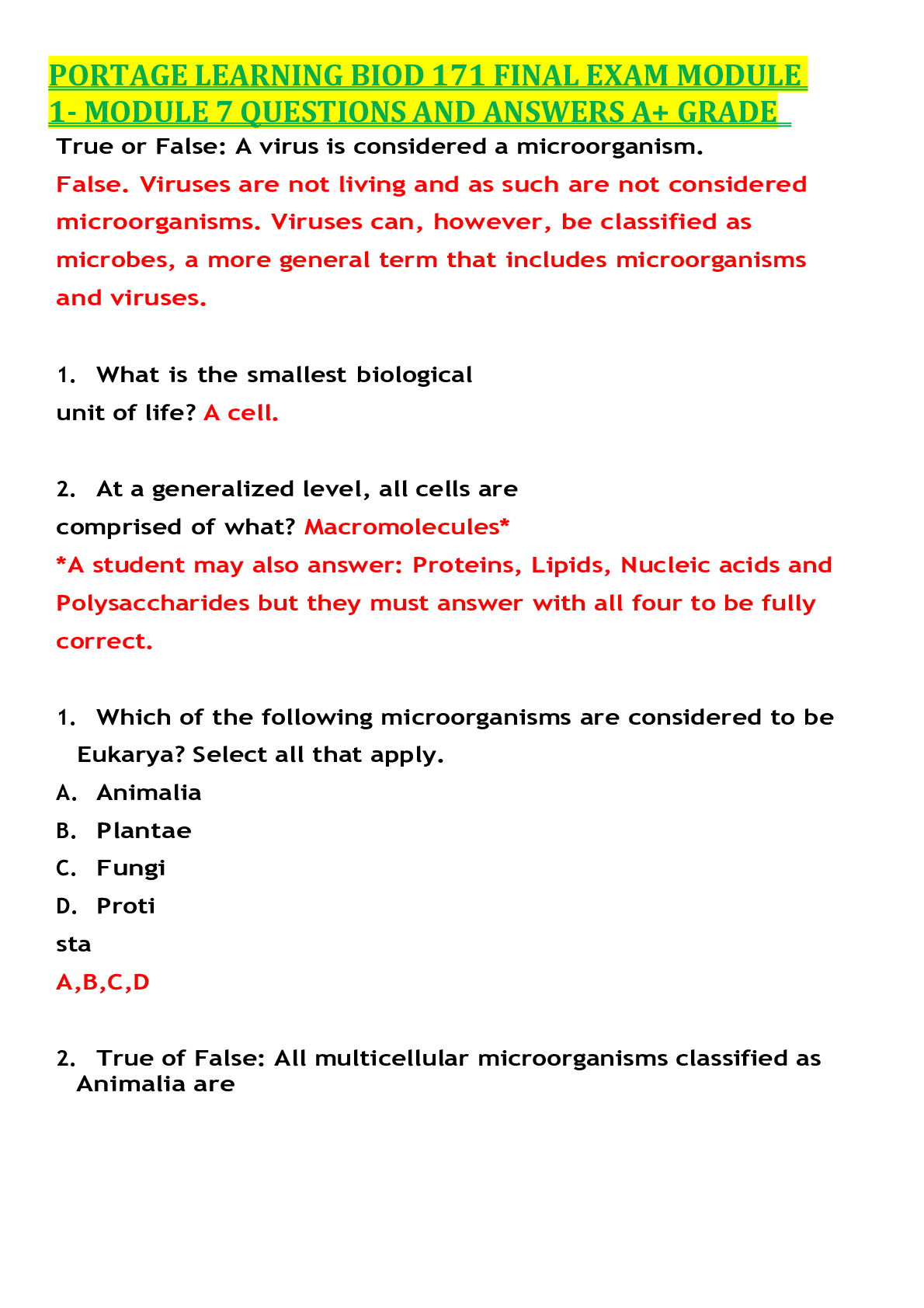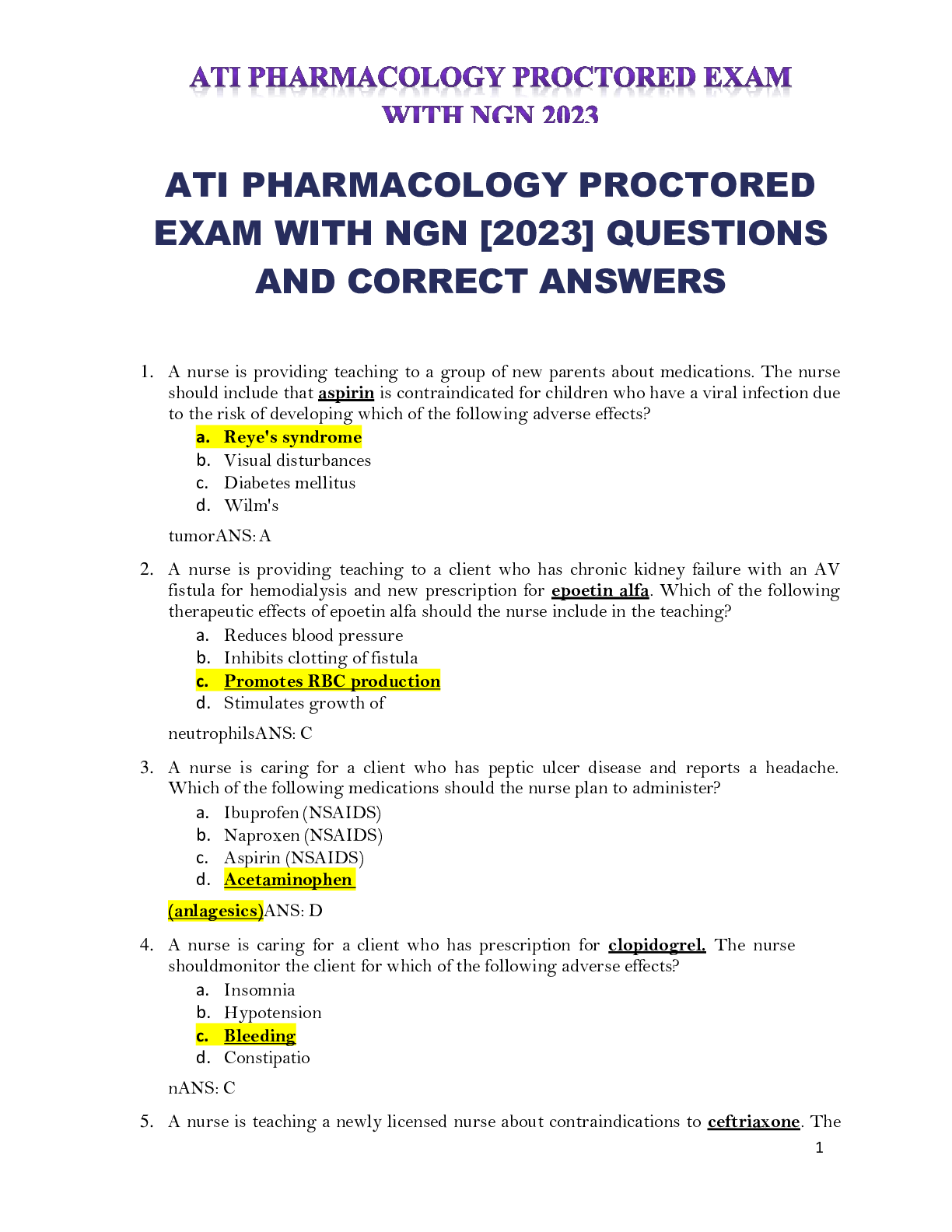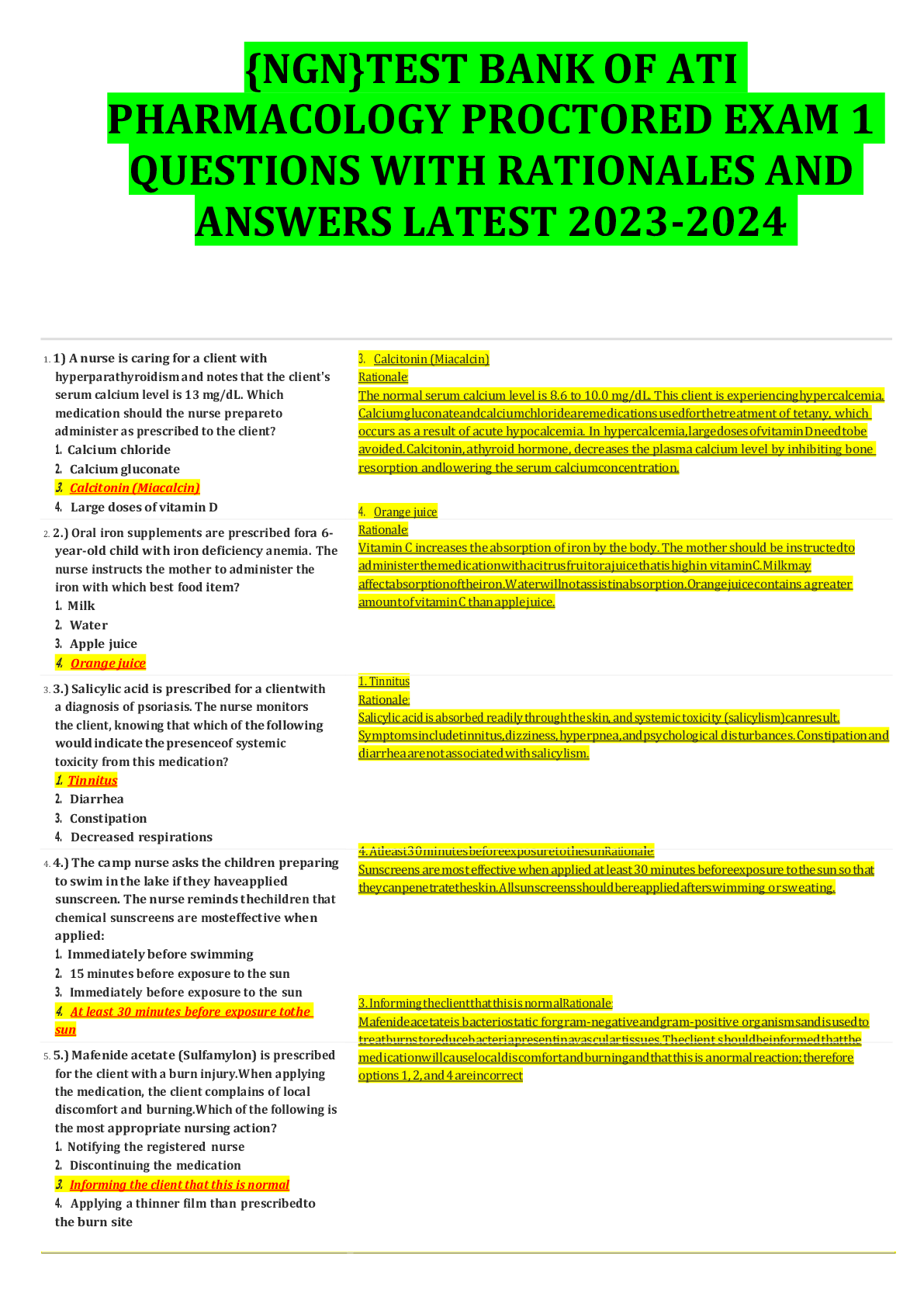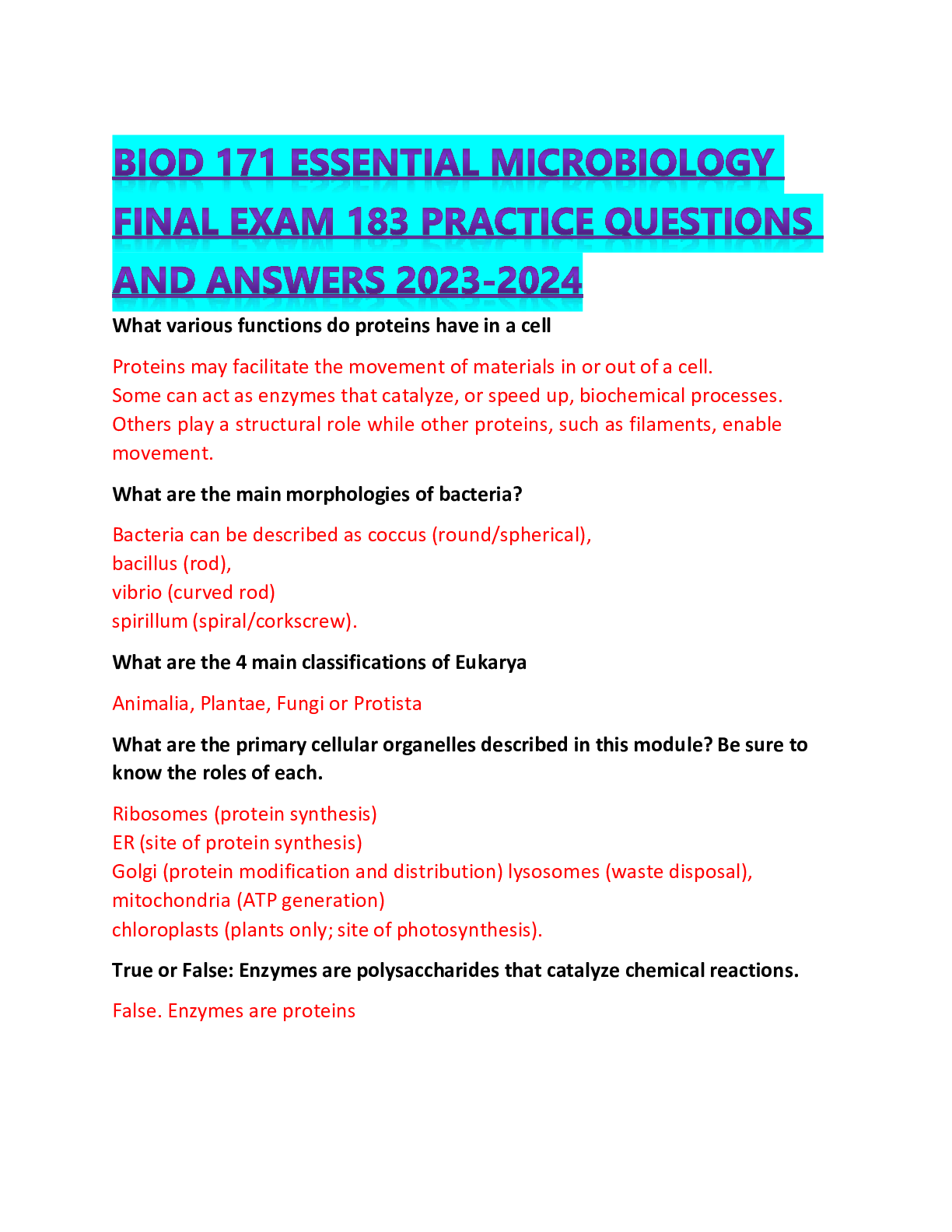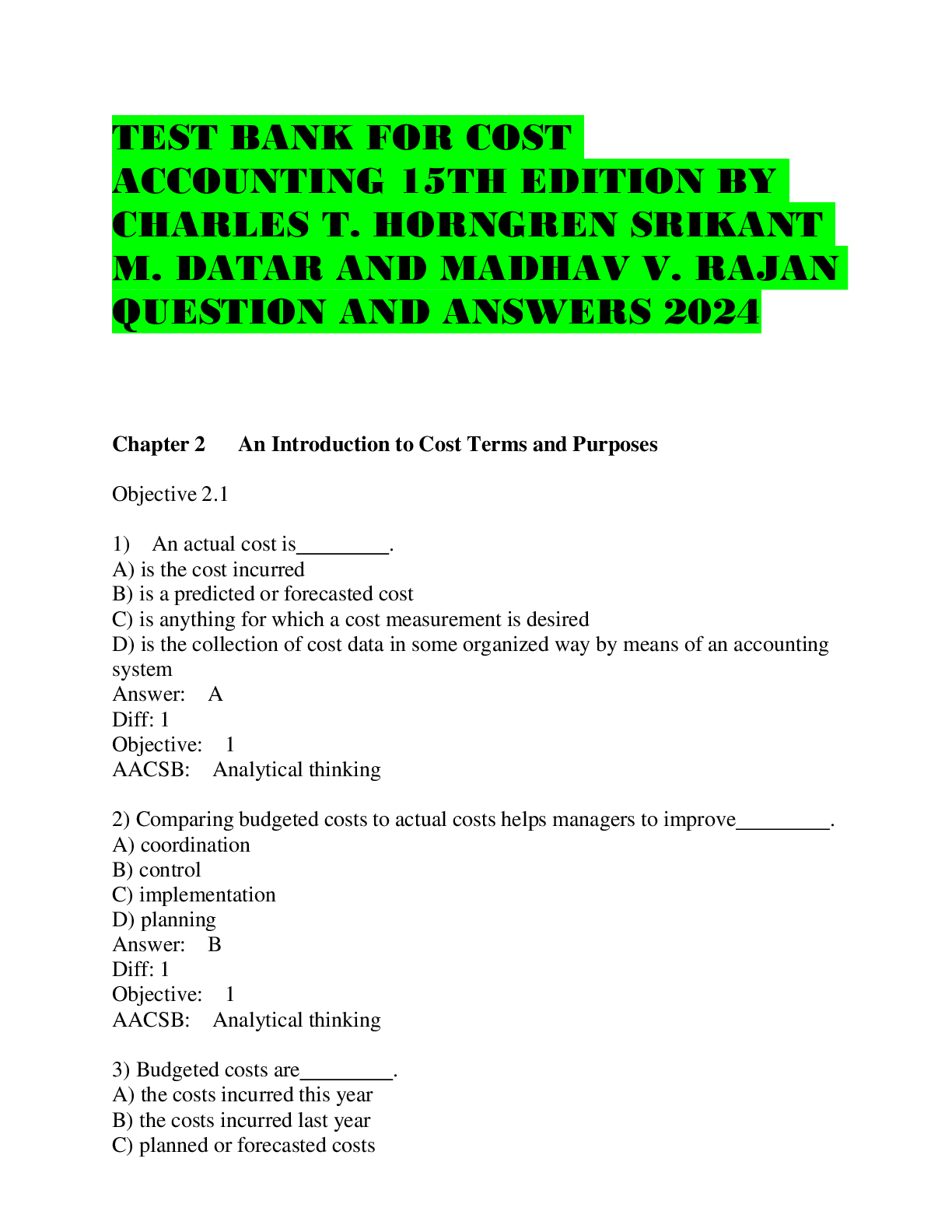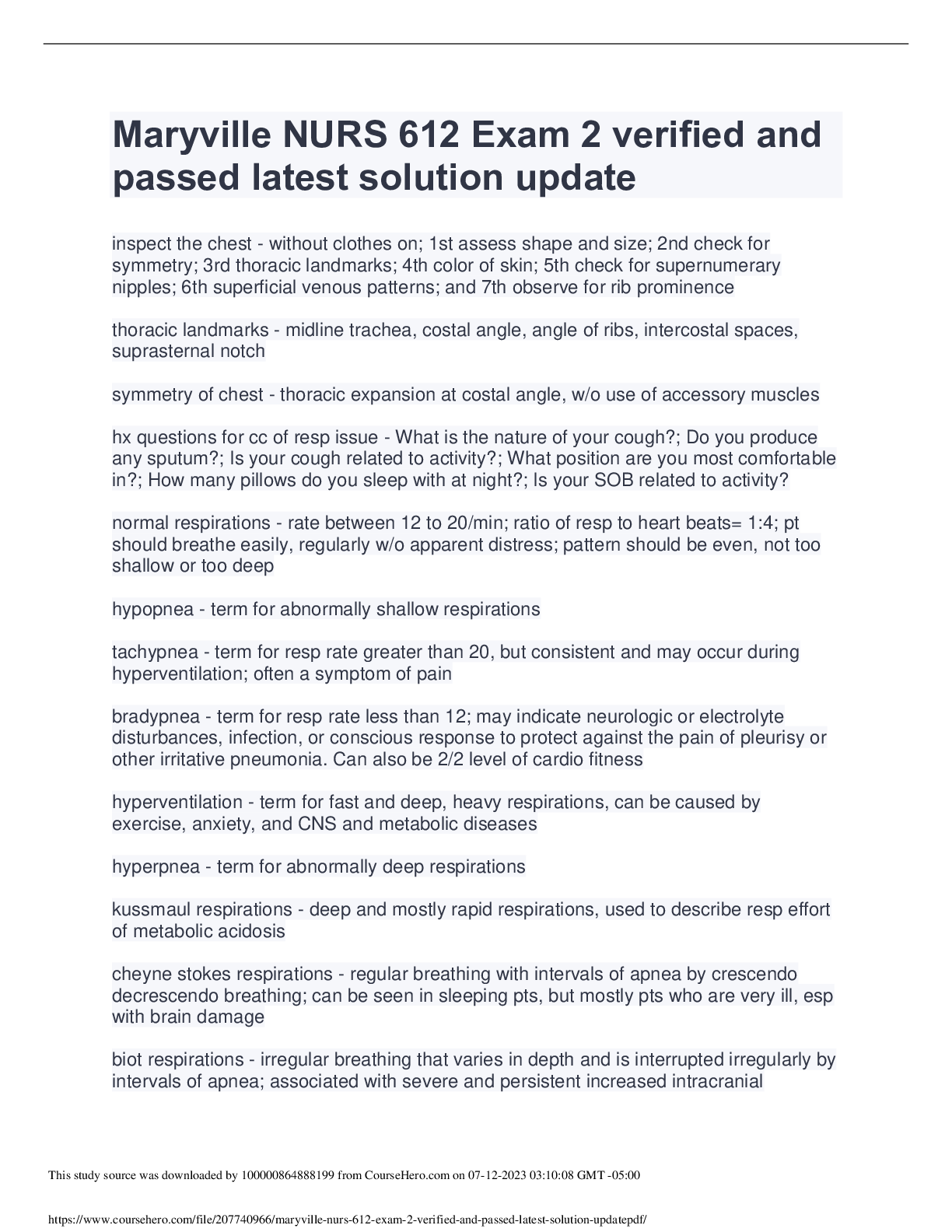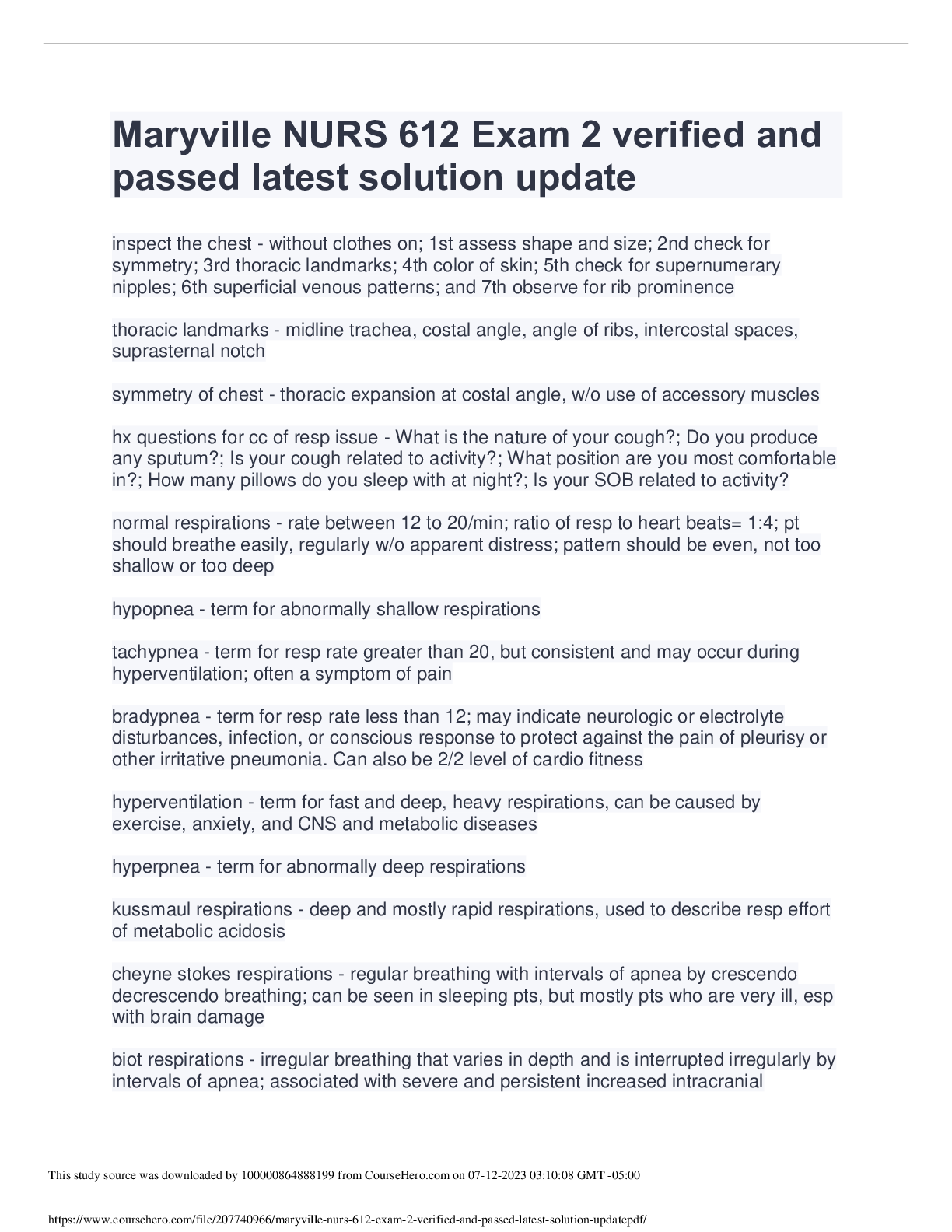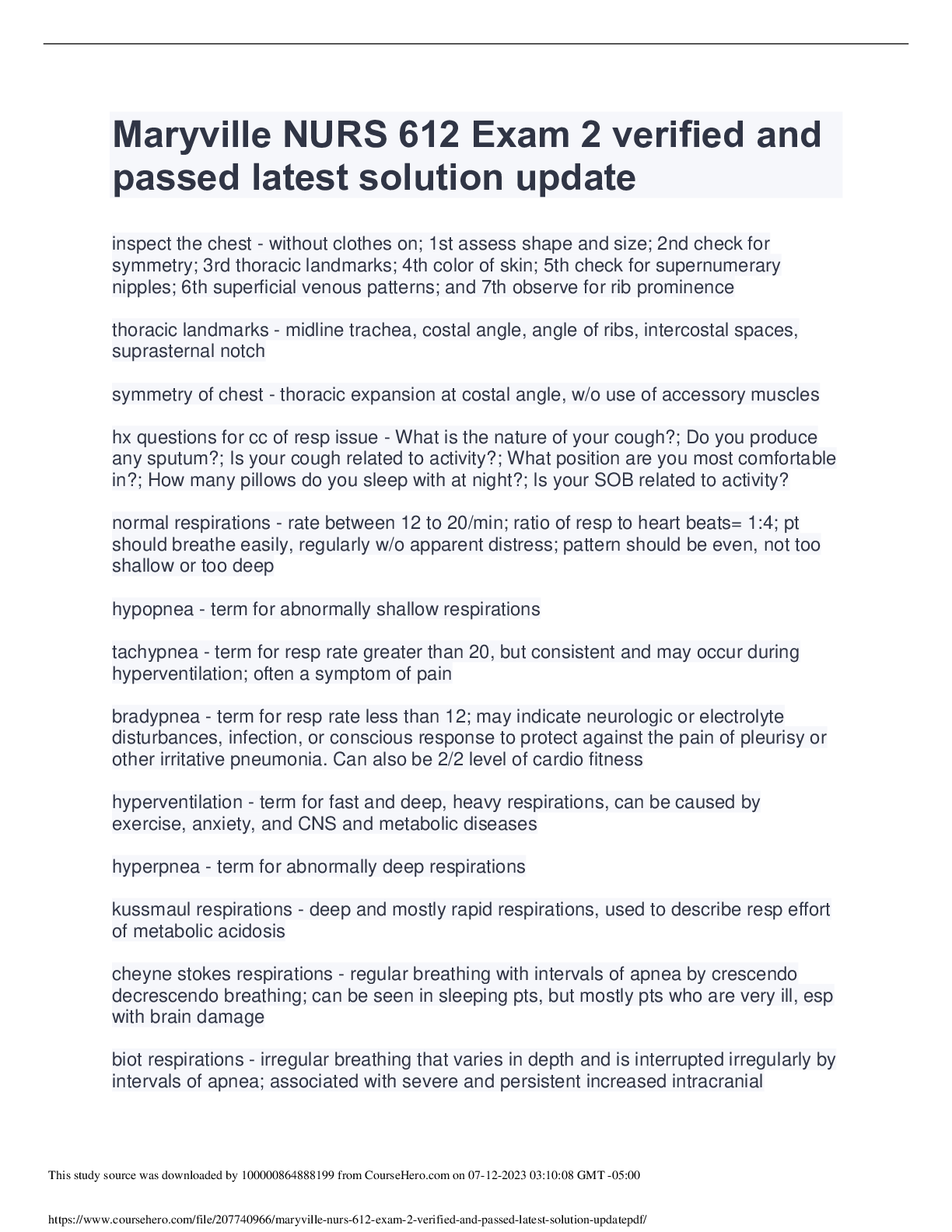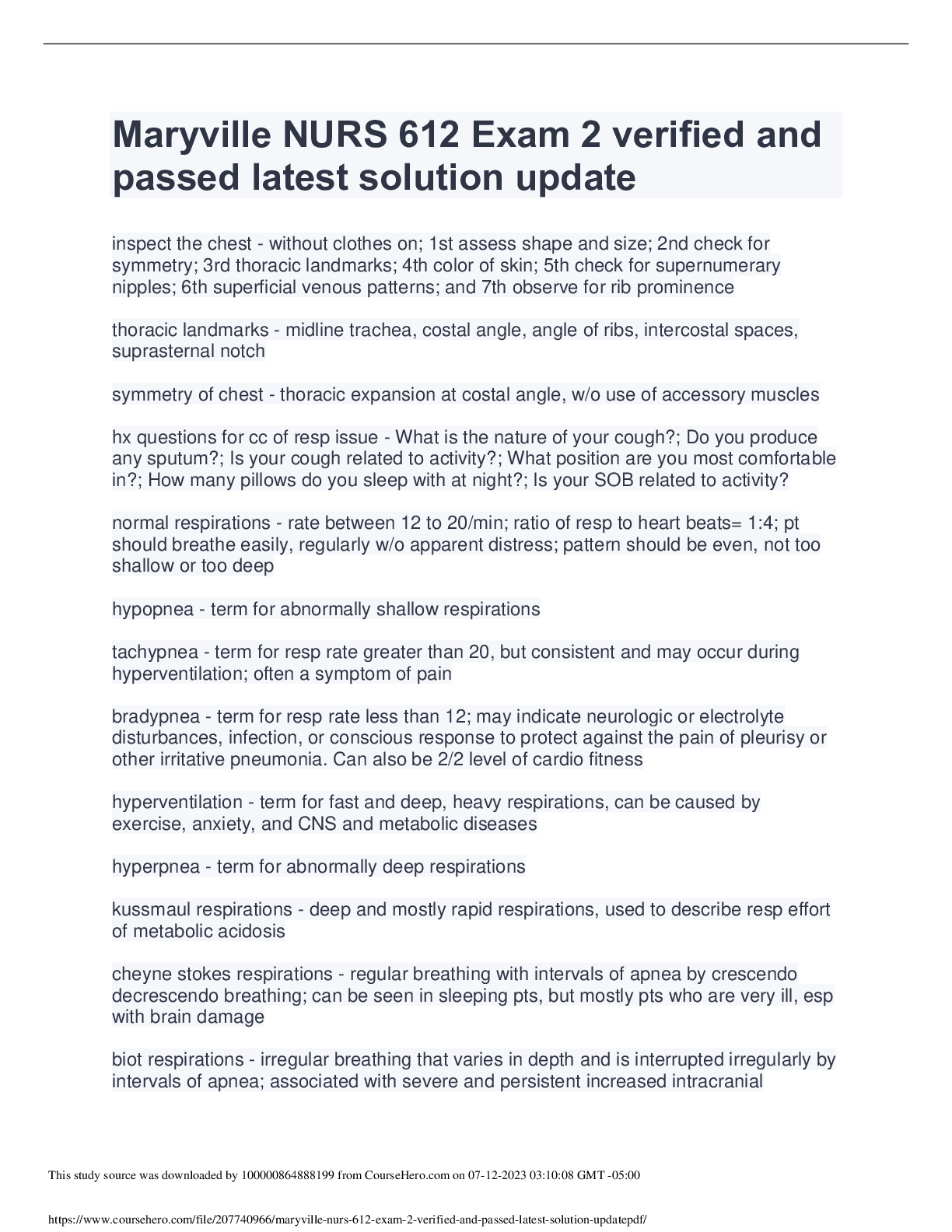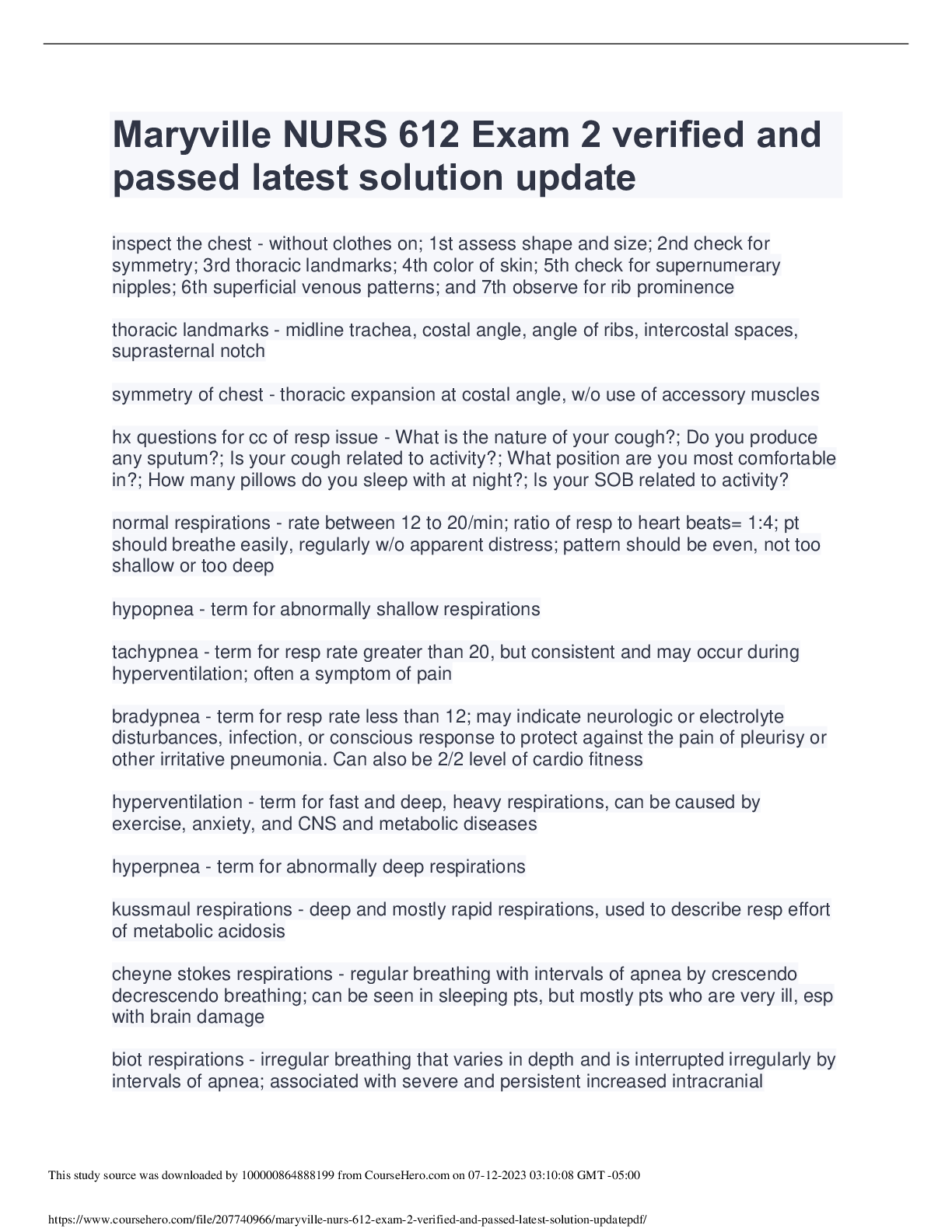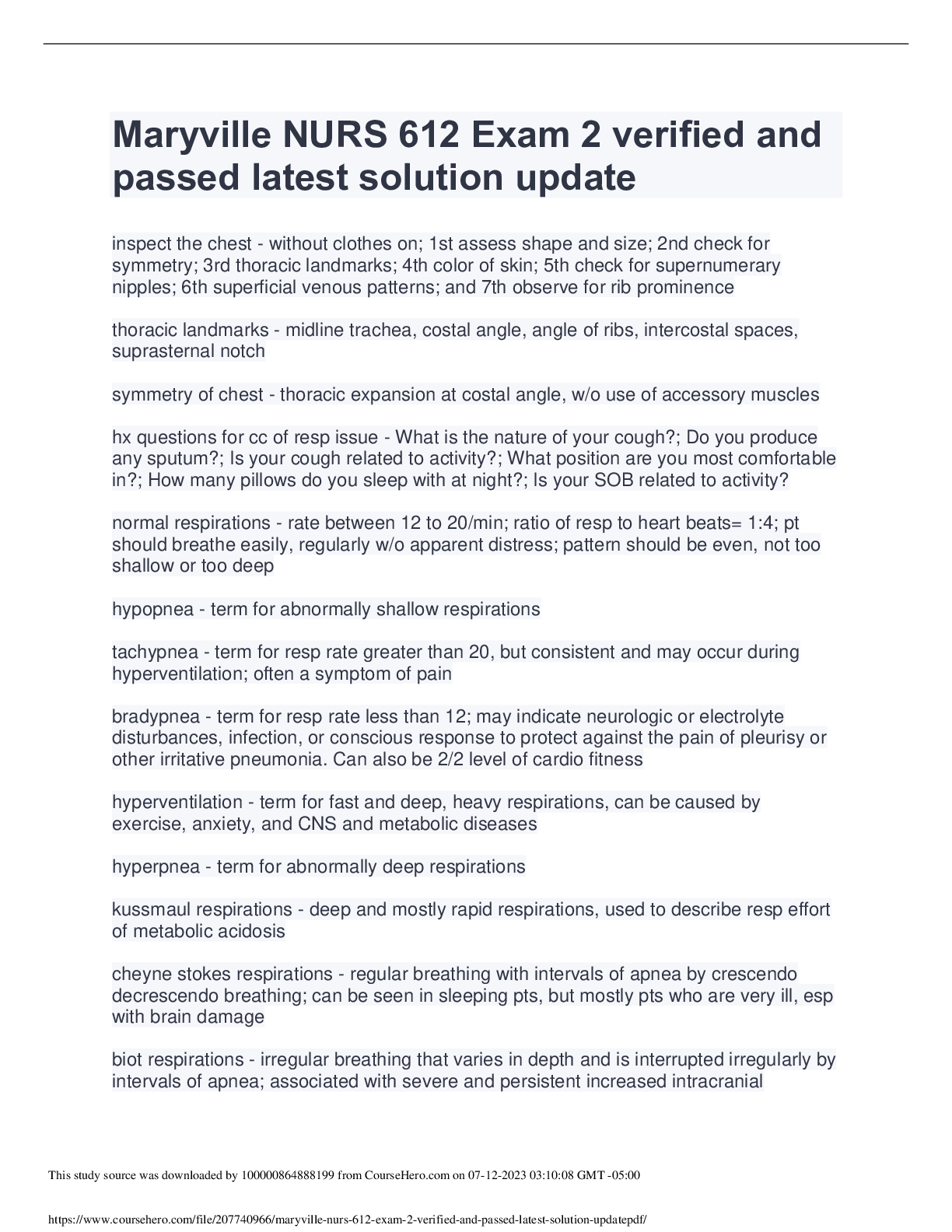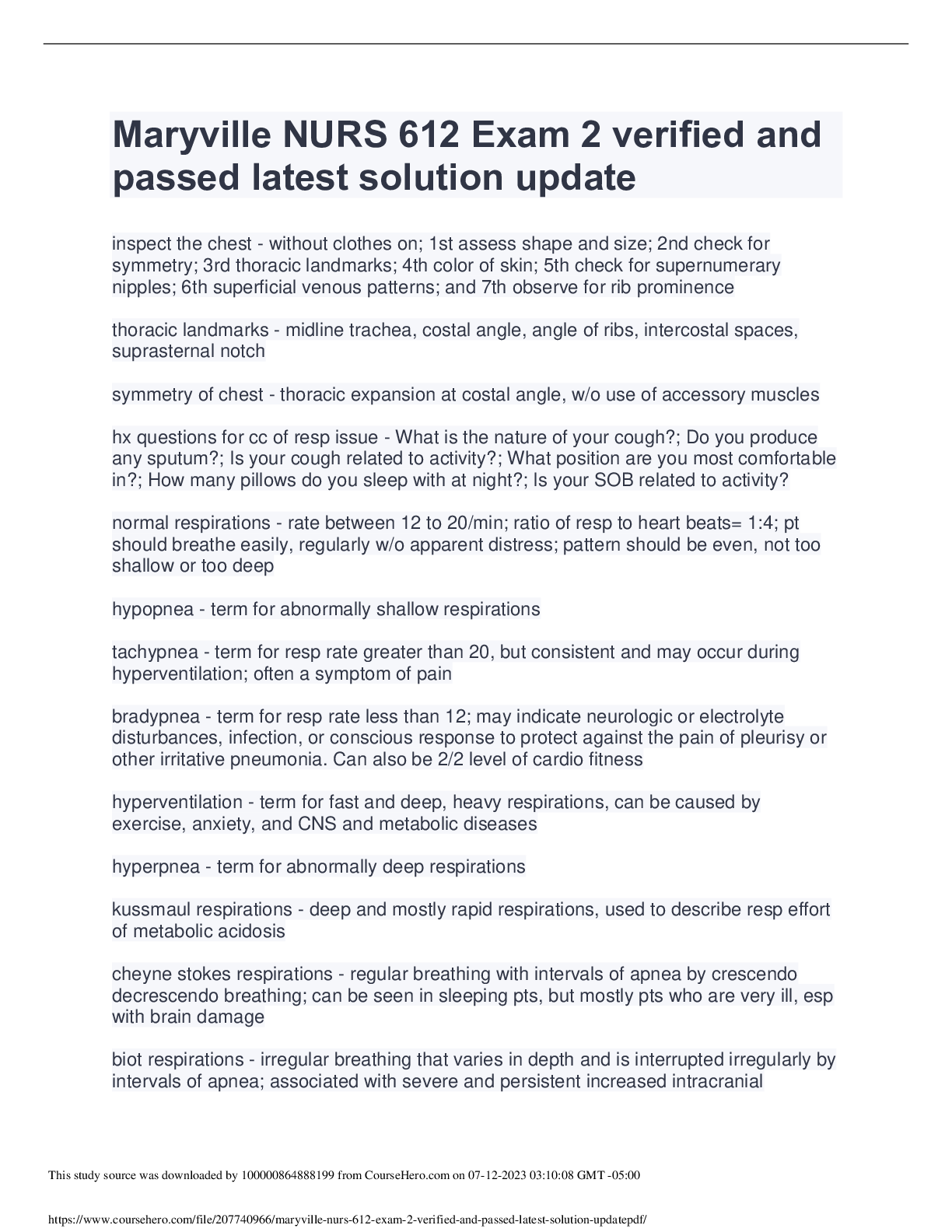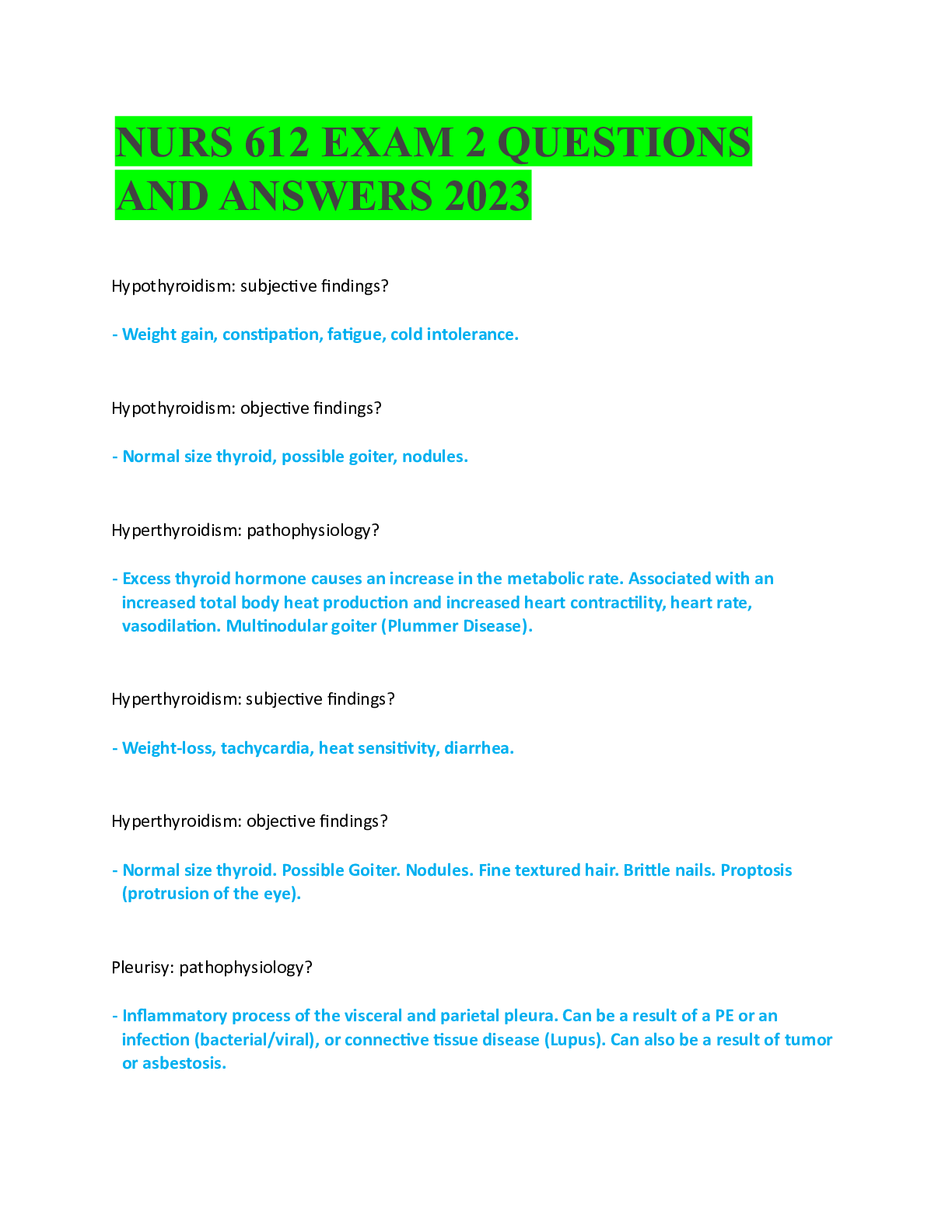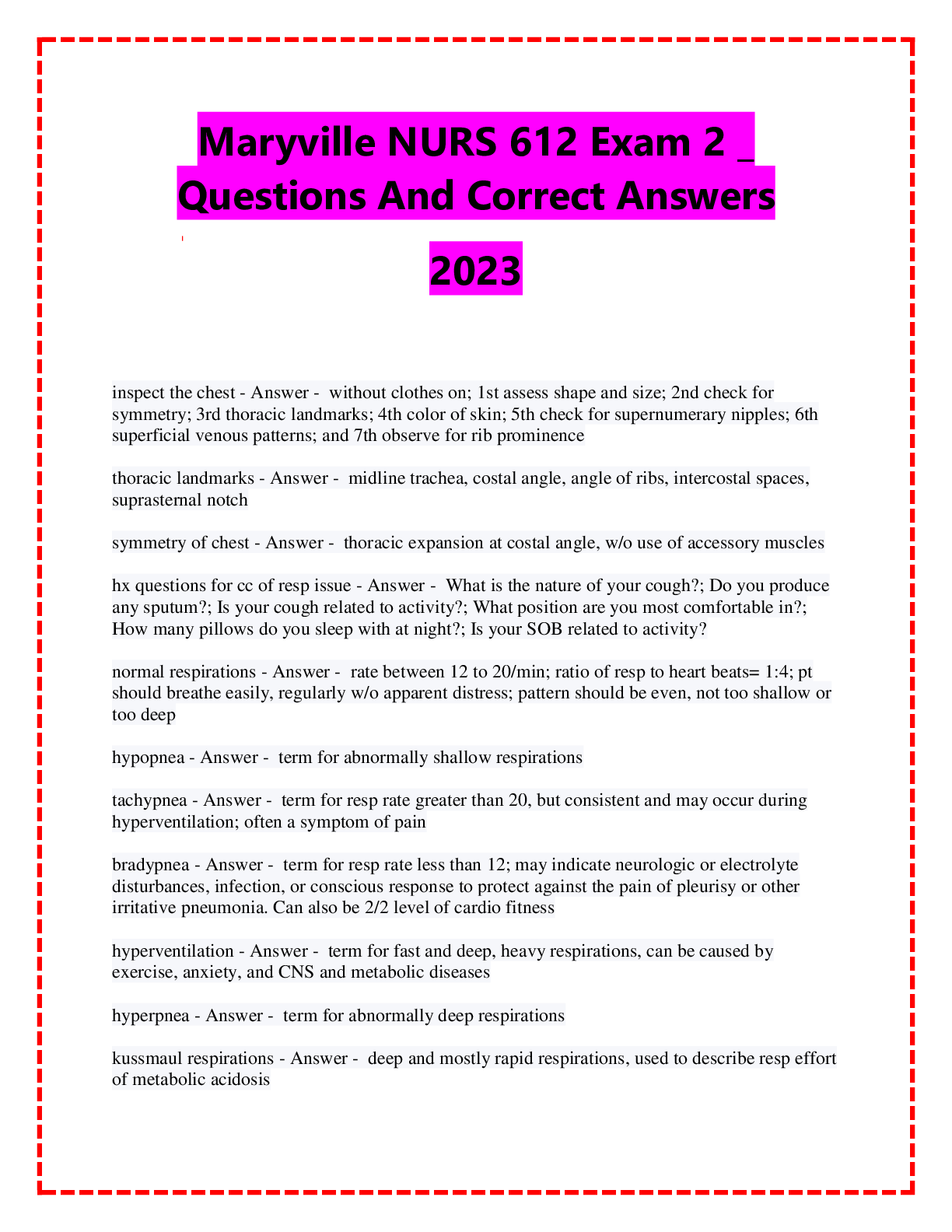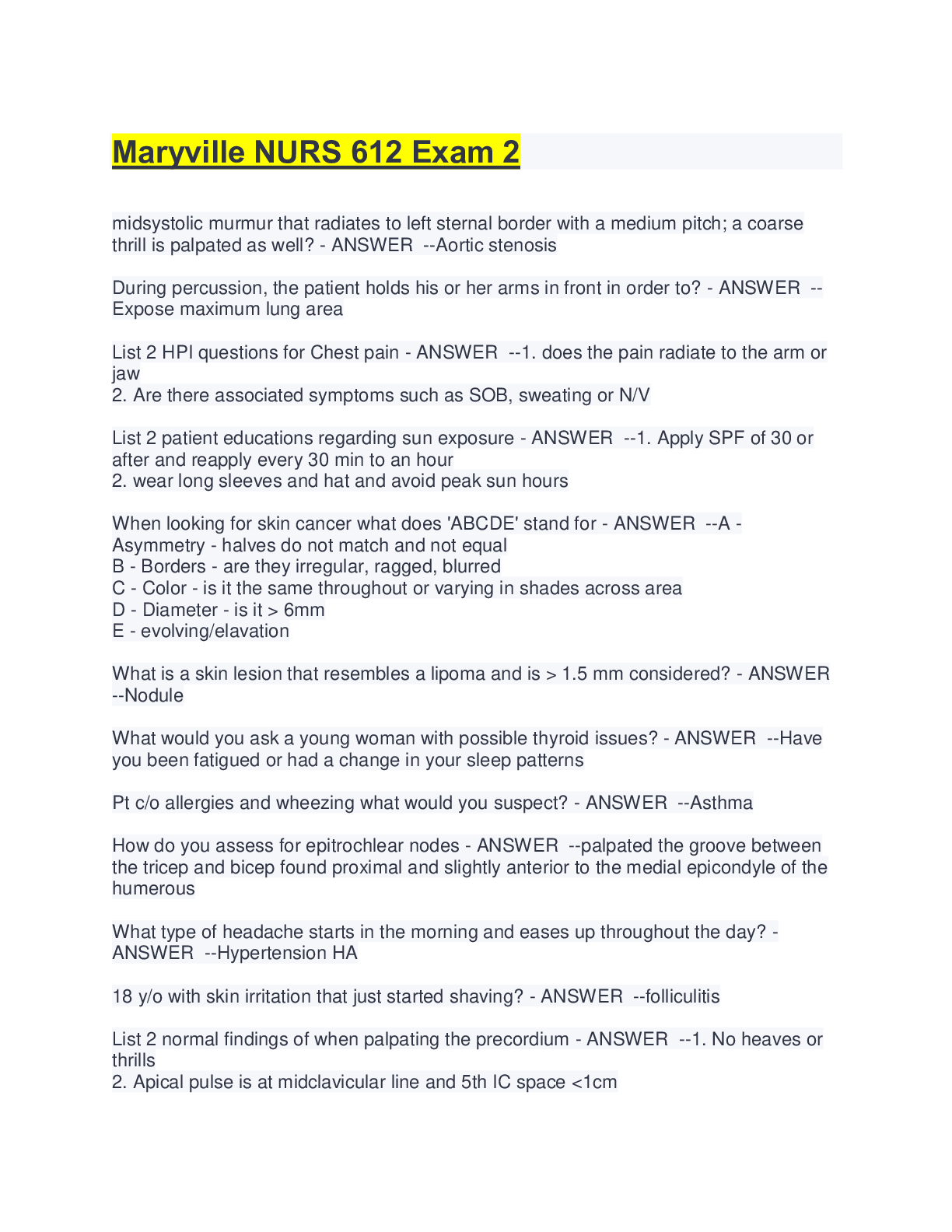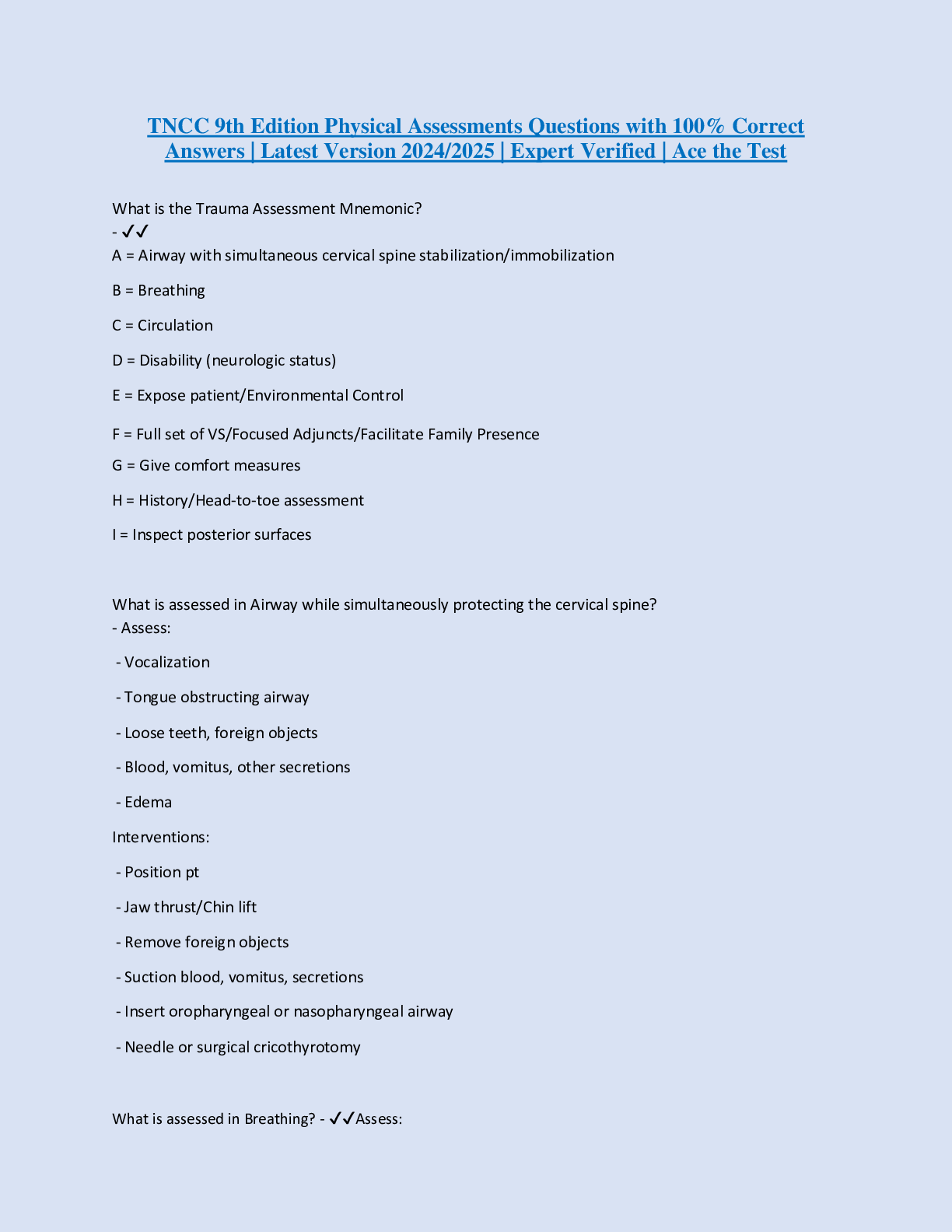[NGN] NURS 612 EXAM 2 MARYVILLE VERIFIED QUESTIONS WITH ANSWERS
Document Content and Description Below
[NGN] NURS 612 EXAM 2 MARYVILLE VERIFIED QUESTIONS WITH ANSWERS inspect the chest - without clothes on; 1st assess shape and size; 2nd check for symmetry; 3rd thoracic landmarks; 4th color of skin; 5... th check for supernumerary nipples; 6th superficial venous patterns; and 7th observe for rib prominence thoracic landmarks - midline trachea, costal angle, angle of ribs, intercostal spaces, suprasternal notch symmetry of chest - thoracic expansion at costal angle, w/o use of accessory muscles hx questions for cc of resp issue - What is the nature of your cough?; Do you produce any sputum?; Is your cough related to activity?; What position are you most comfortable in?; How many pillows do you sleep with at night?; Is your SOB related to activity? normal respirations - rate between 12 to 20/min; ratio of resp to heart beats= 1:4; pt should breathe easily, regularly w/o apparent distress; pattern should be even, not too shallow or too deep hypopnea - term for abnormally shallow respirations tachypnea - term for resp rate greater than 20, but consistent and may occur during hyperventilation; often a symptom of pain bradypnea - term for resp rate less than 12; may indicate neurologic or electrolyte disturbances, infection, or conscious response to protect against the pain of pleurisy or other irritative pneumonia. Can also be 2/2 level of cardio fitness hyperventilation - term for fast and deep, heavy respirations, can be caused by exercise, anxiety, and CNS and metabolic diseases hyperpnea - term for abnormally deep respirations kussmaul respirations - deep and mostly rapid respirations, used to describe resp effort of metabolic acidosis cheyne stokes respirations - regular breathing with intervals of apnea by crescendo decrescendo breathing; can be seen in sleeping pts, but mostly pts who are very ill, esp with brain damage biot respirations - irregular breathing that varies in depth and is interrupted irregularly by intervals of apnea; associated with severe and persistent increased intracranial pressure, resp compromise from drug poisoning, or brain damage at the medulla and generally equals poor prognosis peripheral areas related to respiratory assessment - observe the lips and nails for cyanosis or pallor; lips for pursing; fingers for clubbing; and alae nasi for flaring pleural friction rub - dry, rubbing, or grating sound; palpable, coarse, grating vibration; usually on inspiration; caused by inflammation of the pleural surfaces; think feel of leather rubbing on leather thoracic expansion - stand behind patient and place thumbs along spinal process at level of 10th rib, with palms lightly in contact with the posterolateral surfaces; watch the thumbs during quiet and deep breathing; loss of symmetry = problem on either 1 or both sides. crepitus - crackly/crinkly sensation that can be palpated and heard, a gentle bubbly feeling; indicates air in the subcutaneous tissue from a rupture somewhere in the resp system, or infection with gas producing organism palpating the chest and trachea - palpate the throracic muscles and skeleton; feeling for pulsations, areas of tenderness, bulges, depressions, masses, and unusual movement tactile fremitus - palpable vibration of the chest wall that results from speech or other verbalizations. best felt posteriorly and laterally at the level of the bifurcation of the bronchi; have patient say "99" while you palpate with palmer surface of fingers or ulner aspect of the hand; use firm, light touch abnormal tactile fremitus - decreased of absent fremitus may be caused by excess air in lungs or may indicate emphysema, pleural thickening, or effusion, massive pulm edema, or bronchial obstruction. Increased fremitus often coarser or rougher in feel, caused by presence of fluids or solid mass within the lungs. 7 characteristics of enlarged lymph nodes - location, size and shape, consistency, mobility, discreteness, tenderness, and warmth occipital lymph nodes - lymph nodes at the base of the skull postauricular lymph nodes - lymph nodes over the mastoid process, behind the ear preauricular lymph nodes - lymph nodes in front of the ear parotid and retropharyngeal lymph nodes - lymph nodes at the angle of the mandible (tonsillar) submandibular lymph nodes - lymph nodes halfway between the angle and tip of the mandible submental lymph nodes - lymph nodes in the midline behind the tip of the mandible superficial cervical lymph nodes - lymph nodes at the sternocleidomastoid muscle posterior cervical lymph nodes - lymph nodes along the anterior border of the trapezius muscle cervical lymph nodes - lymph nodes deep to the the sternocleidomastoid, must probe gently w/ your thumb and fingers around the muscle supraclavicular area lymph nodes - lymph nodes that you must probe deeply in the angle formed by the clavicle and sternocleidomastoid muscle, common sites for metastatic disease axillary lymph nodes - lymph nodes found by supporting pt's forearm w/ your non exam arm; and by bringing the palm of your exam hand into the axilla. Let the soft tissues roll b/w your fingers and the pt's chest wall and muscles. Rotate your fingertips and palm to feel for the nodes. epitrochlear lymph nodes - lymph nodes found by supporting pt's arm in one hand as you explore with your other hand in the groove of the elbow b/w the triceps and biceps muscles inguinal lymph nodes - lymph nodes found by having the patient lie supine, feel for the superior inguinal lymph nodes (femoral) that lie close to the surface over the inguinal canals. Assess the inferior superficial inguinal lymph nodes which lie deeper in the groin 6 characteristics of skin assessment - color, uniformity, thickness, symmetry, hygiene, and lesions popliteal lymph nodes - lymph nodes found by flexing the supine pt's knee and wrapping your hand around it and palpate the fossa with your fingers 5 characteristics of the skin - moisture, temperature, texture, turgor, and mobility documentation of skin lesion - size, shape, color, texture, elevation, depression, attachment, exudate, configuration, location and distribution, subtle details, transillumination, and shine a wood's lamp on it nevi - normal skin lesions macule - a flat, circumscribed area that is change in color of skin, less than 1 cm (freckles, flat moles, measles) [Show More]
Last updated: 5 months ago
Preview 1 out of 7 pages
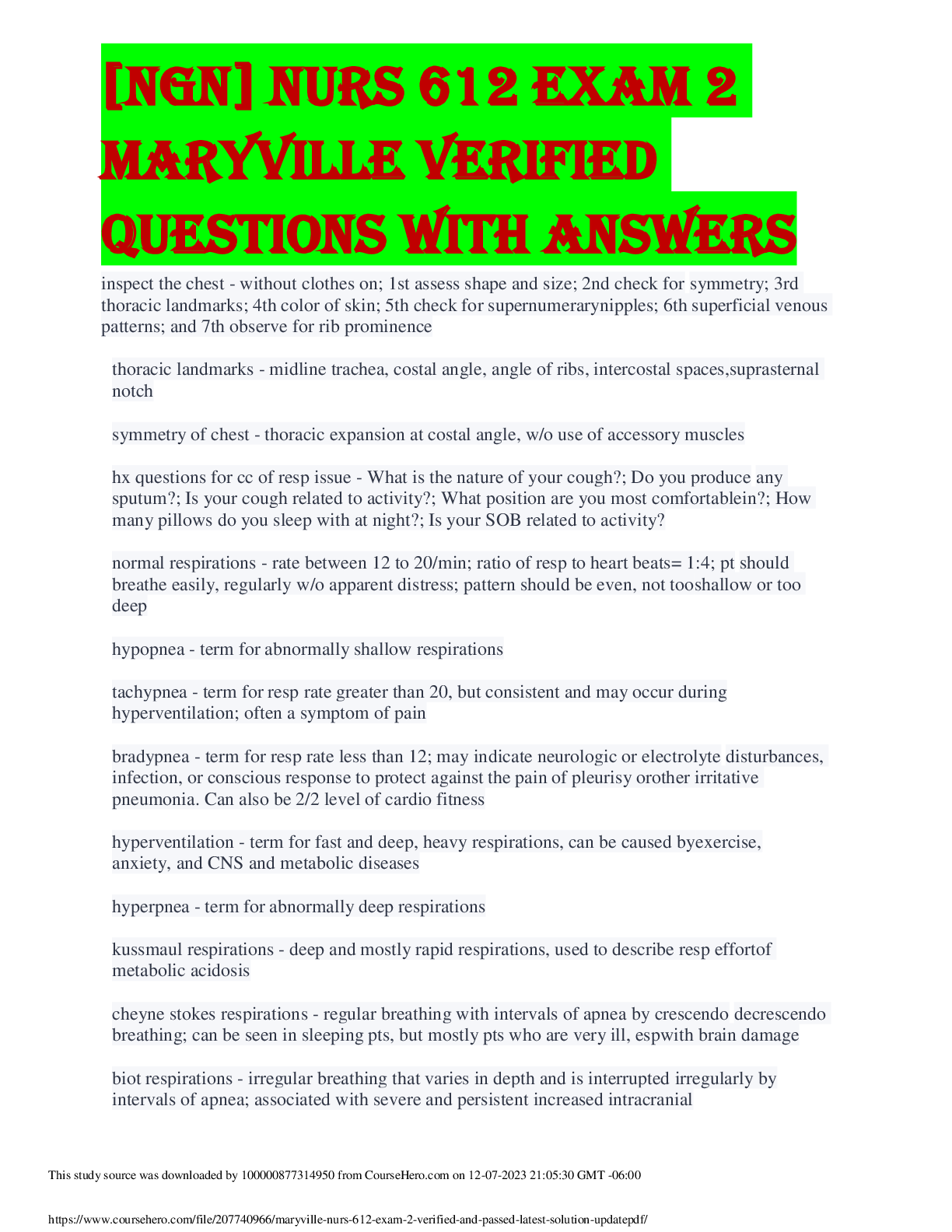
Reviews( 0 )
Document information
Connected school, study & course
About the document
Uploaded On
Dec 08, 2023
Number of pages
7
Written in
Additional information
This document has been written for:
Uploaded
Dec 08, 2023
Downloads
0
Views
19

